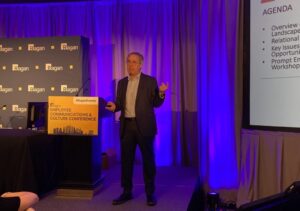The ABCs of writing great employee emails
Tools of the trade from UC San Diego Health’s editor-in-chief.

Artfully telling stories that draw employees in is a thoughtful process of creating content that captivates, informs and even delights readers.
Keeping your audience invested takes skill, which Rachel Thomae, editor-in-chief of the UCSD Physician/APP Update newsletter at UC San Diego Health, said is a blend of science and creativity.
“I feel like people are wired to listen to stories and learn from stories, and also remember stories,” Thomae said. “So, I think it’s really important to use stories as a way to not just entertain people but to provide people with information in a way that they can really connect to it, that they can engage with it, and also that they can remember it.”
These are Thomae’s tips for making your employee communications resonate:
The ABCs of compelling corporate narratives
To Thomae, successful content means going beyond doling out company data or information.
“Sometimes with employee communications, it’s easy to just present the facts and send out emails,” Thomae said. “When you add storytelling to that, it just makes it easier for people to be engaged with … the information and it also helps them to remember it and to share it as well.”
Thomae put that into practice when she started the company newsletter about five years ago to consolidate numerous one-off emails physicians received.
One of those many emails was an annual company celebratory event invitation for physicians and their families.
To drum up more interest, the newsletter featured event preview stories and past event photos leading up to the celebration. It quickly became a big hit.
“We include quotes from our providers who enjoyed the event the year before,” Thomae said. “So, what happens is people read about it in the newsletters and they tell their colleagues. Positioning it as a story instead of just information makes people more excited to share it with other people.”
How do you get content that engages and entices? By getting to the fundamentals of storytelling and crafting compelling company narratives, which begins with knowing your ABCs:
Considering your audience
“For me, the audience is more than just a particular group of people,” Thomae said. “To me, the audience is a group of people you get to know.”
Well before Thomae’s newsletter goes out every Wednesday at 6 p.m., her audience of 5,000 physicians, advanced practice providers and medical students is on her mind.
She wants to know what they’re interested in reading about in the medical field. She consults her physician-based editorial team weekly to learn what their peers find new and interesting. Thomae relies on this rotation of physicians to assist in creating these articles.
“What’s timely and relevant to them?” Thomae said. “How are they going to consume (this)?”
Once Thomae knows what her audience is interested in, she asks more questions including:
- What’s the message of the story?
- Why is this important?
- How will they benefit from what you have to say?
When Thomae finds the most important message, she does what she calls a “bottom line on top” method, similar to an inverted pyramid in journalism.
“I take that message and put (it) at the top of the story or article and that allows people to engage immediately instead of reading through several pages to find out,” Thomae said. “That was very important for our audience to get straight to the story and see the immediate benefit and how it benefits them.”
Thomae and her team also highlight timely medical topics and events like Infectious Disease Week. The article topic for that week would be written by an infectious disease doctor.
“(Readers) knew that they would have the most up-to-date information,” Thomae said. “They knew that they could trust what they have to say. This is where it helps to have other physicians (writing). Having their input is really crucial.”
Cultivating connection
Connecting with internal audiences means writing interesting stories, emails or other forms of content that can help take them from point A to point B.
“With employee communication specifically, what do you want people to do?” Thomae asked. “We want people to open what you’ve sent them.”
Thomae said to make that connection, make sure your messaging has a great subject line or headline. Lose jargon and general statements and personalize the message. Thomae also adds eye-catching newsletter quotes from physicians in the body of the email. This adds some pizzazz and gets other physicians curious about what their colleagues are talking about, she said.
“Figure out what it is people want to hear and tell the story people are looking for,” Thomae said.
Hear more about employee comms from Thomae and others by joining us at Ragan’s Employee Communications 101 Virtual Conference on Jan. 25!
Sherri Kolade is a writer and conference producer at Ragan Communications. She enjoys watching old films, reading and building an authentically curated life. Follow her on LinkedIn. Have a great PR/comms speaker in mind for one of Ragan’s events? Email her at sherrik@ragan.com.







